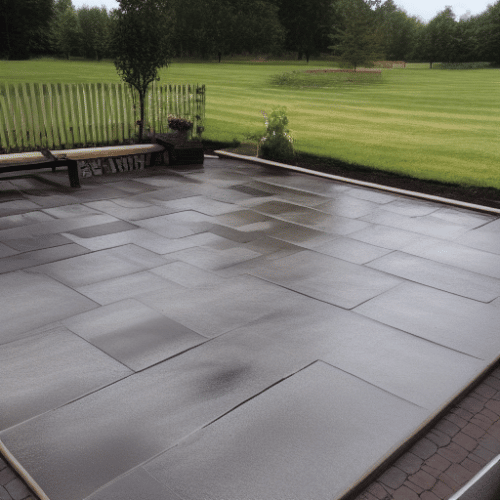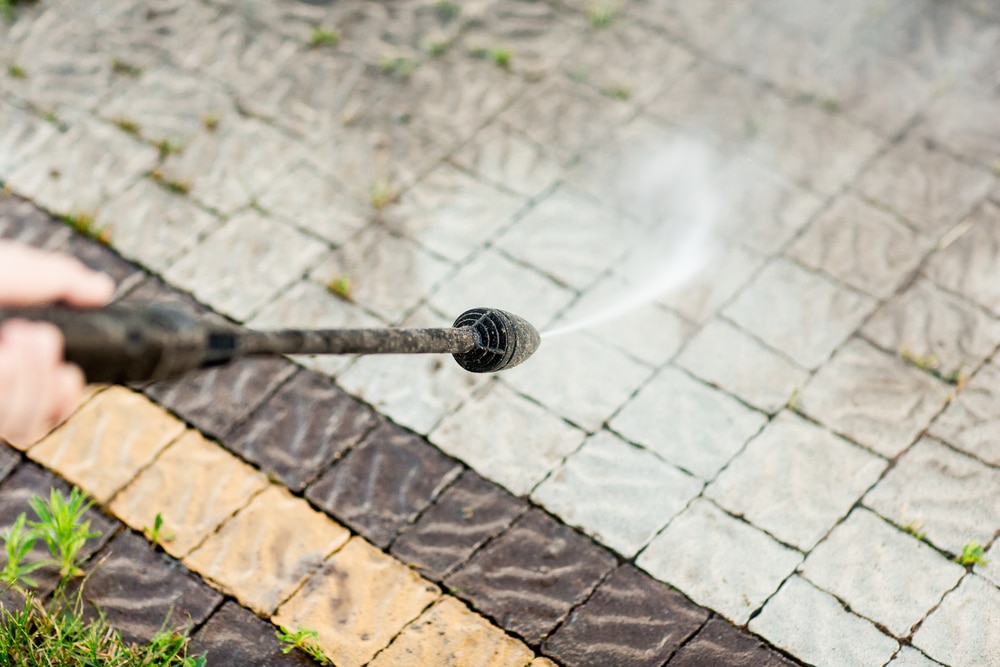Last Updated on
Your patio is a great place to relax and enjoy the outdoors. But it can be even more enjoyable if it’s clean and sparkling!
In this comprehensive guide, we will discuss some tips and tricks on how to clean patio slabs. We’ll also offer some useful methods for removing stains and avoiding further fading. Let’s get started!
How to Clean Patio Slabs With a Pressure Washer
For cleaning concrete patio slabs, pressure washers are useful tools since they remove debris and dirt quickly. Below are the steps for cleaning paving slabs with a pressure washer:
Step 1: Remove Leaves, Weeds, and Debris
Remove any debris, dirt or leaves. This will help to ensure that the pressure washer can do its job correctly. Also, remove weeds by hand or with a weed killer.
Step 2: Sweep the Entire Patio
Sweep your patio to remove any loose debris, dust or dirt. This will prevent spreading dirt when you use your pressure washer.
Step 3: Spray the Area With Water
Spray down the area with water from your hose to loosen up any dirt and debris for easy cleaning later on. This will also help prevent splattering when using the pressure washer later.
Step 4: Prepare Your Cleaning Solution
In a bucket or spray bottle, mix water and dish soap. Be sure to use mild dish soap.
Step 5: Spray the Solution on the Paving
Spray or pour the solution onto the patio paving slabs and allow it to soak in for a few minutes.
Step 6: Set Up Your Pressure Washer
Set it up and begin spraying the patio slabs if you have a pressure washer. Focus on built-up dirt, grime, and algae or moss that may be on your patio’s concrete surfaces.
Position the nozzle approximately 18 inches away from the surface to avoid damaging the pavers. Maintain an angle of 45 degrees when spraying water on the paving slabs.
Start from top to bottom in a sweeping motion, and cover all sides of each slab. Wait a few minutes for the dirt and debris to loosen.
Step 7: Clean Up Any Standing Water

Once you’ve finished pressure washing the paving slabs, clean up any standing water and allow them to dry completely before allowing foot traffic again or putting back your patio furniture and plant pots.
How to Clean Patio Slabs Without a Pressure Washer
You can still clean patio slabs without a pressure washer. Using a soap and water solution and a garden hose is best for cleaning more delicate paving slab materials. Follow these steps:
Step 1: Wet the Entire Patio
Wet the paving area with water from a garden hose to help loosen any dirt or debris. If there is any built-up grease or oil, use a degreaser to help break it up.
Will give it one more hose down to get the final bits of sand, but my dad and I are done with the back patio! pic.twitter.com/MmXcrI0x5g
— Jake (@AtomicSonic) February 2, 2022
Step 2: Give the Slabs a Good Scrub
Pour some dishwashing soap onto the paved area and then scrub with a hard-bristled brush. Cleaning paving involves simple brushing, but ensure to clean in all directions to remove any dirt or stains.
Step 3: Remove Tough Stains and Dirt
If you have any tough stains or dirt that won’t come off with just the soapy solution, you can use a mixture of water and baking soda.
Mix baking soda with two parts of water in a spray bottle and spray it onto the stain. Let it sit for two minutes before scrubbing it with a hard-bristled brush, and then rinse it off with water.
Step 4: Rinse the Slabs
Attach a nozzle to your hose and rinse off any remaining soap and dirty water from the slabs.
Step 5: Wipe Off Standing Water
Remove any standing water with a sponge or towel. This will help prevent the formation of mould or mildew.
How to Clean a Patio Without Chemicals

If you are interested in using a more eco-friendly method of cleaning paving slabs, try using white vinegar. Vinegar is a natural household disinfectant that won’t harm plants or animals and can be used on any surface. It will also help clean algae from patio slabs. Follow the guide below:
- Clear away any leaves, weeds, and debris.
- Next, spray water onto the slabs with a hose to loosen any dirt or debris.
- Fill a spray bottle with equal parts white vinegar and water, then apply to the slabs. You can add more vinegar as necessary.
- Let the mixture sit for at least 15 minutes before scrubbing off each paving slab with a brush or sponge.
- Rinse off the vinegar with water from a hose, and wipe off any standing water.
How to Clean Patio Slabs With Bleach
If you have stubborn stains on your patio or turned green with algae growth, try using bleach. Follow these steps for the best results:
- Combine one part bleach and ten parts water in a large bucket.
- Apply the solution to the affected area using a sponge mop or scrub brush.
- Allow the bleach solution to sit for 15 minutes or so, then rinse with clean water. You can also try using non-chlorine bleach if you’re concerned about the chlorine in regular bleach.
Things to Remember When Cleaning Paving Slabs

Here are a few essential things to keep in mind when cleaning your dirty patio:
- One of the crucial things to remember before cleaning your patio is knowing what paving material you have. Each material has its own recommended cleaning method.
- If you’re using a power washer or pressure cleaner, be careful not to damage the surface of your slabs by using too much pressure. Start at a low setting and work your way up if needed. Read the manufacturer’s instructions carefully and use caution when operating the machine.
- It is recommended not to use a harsh patio slab cleaner. There are many environmentally friendly cleaning products available.
- Regardless of the cleaning methods you choose, always test any cleaning solution on an inconspicuous section of your patio area first.
- Always keep safety in mind; pressure washer spray can cause injuries when misdirected.
- If you’re going to use a chemical-based patio cleaner, it is best to wear protective gear such as gloves and goggles.
- Never mix different chemicals because the reaction can be dangerous or even fatal.
- You should always clean your patio so that you don’t have to do a deep cleaning every time! Removing weeds, sweeping, and regular brushing with a water and soap solution are enough for regular maintenance.
- Make sure to sweep the area clean before you start cleaning, making the cleaning process a lot easier.
Regular cleaning and maintenance of paving slabs can be a daunting task, but it doesn’t have to be with these tips! Follow these simple steps, and your outdoor space will look sparkling in no time!
Frequently Asked Questions About Cleaning Patio Slabs
Is Vinegar Effective for Cleaning Patio Slabs?
Yes. Mix half water and half white vinegar in a spray bottle, then apply it onto each paving slab with a sponge or mop. Let it sit on the entire surface for about 15 minutes before rinsing off!
Will Vigorous Scrubbing Damage My Concrete Paving Slabs?
Vigorous scrubbing can damage paving materials. To avoid damaging your slabs, use a scrub brush and make sure that you’re applying an even amount of pressure when scrubbing off dirt or debris from the surface!
What Is the Best Way to Clean Paving Slabs?

The best way to clean your patio is with a pressure washer and a mild detergent. An environmentally friendly cleaning solution like white vinegar or baking soda is also suitable for this cleaning task.
Is Warm Water Ideal for Patio Cleaning?
Yes, you can use warm water for patio cleaning. It will help loosen stubborn dirt and stains.
Can I Clean a Natural Stone Patio With Soapy Water?
A gentle soap and water solution is suitable for cleaning patios. It does the job without damaging the top layer of the natural stone slabs.
Keeping Patio Slabs Clean and Looking New
Now that you know how to clean patio slabs efficiently, you can enjoy spending more time outdoors this summer! But remember, regular cleaning and maintenance are vital for keeping your slabs looking new.
For more tips on keeping your outdoor space looking its best, be sure to check out our blog regularly.
In this blog post, we will discuss some tips and tricks on how to clean patio slabs. We’ll also provide some helpful tips on getting rid of stains and preventing fading in the future. Let’s get started!
Paul is the type of person who never met a problem he couldn’t fix. He can always be found tinkering with something in his house, even if it isn’t broken! His tips and tricks are often shared on our site. He’s the one you call when something breaks because he has been known to improvise fixes for everything from leaky faucets to malfunctioning dryers.



